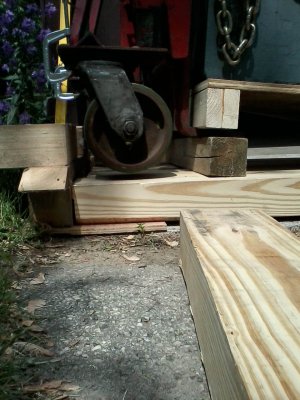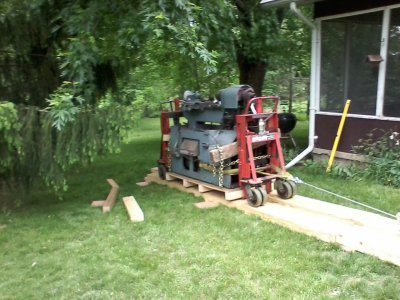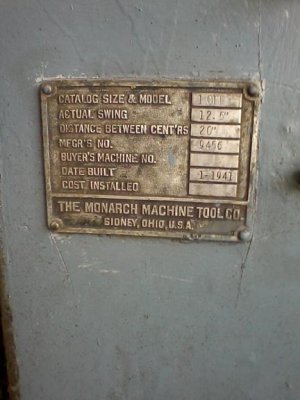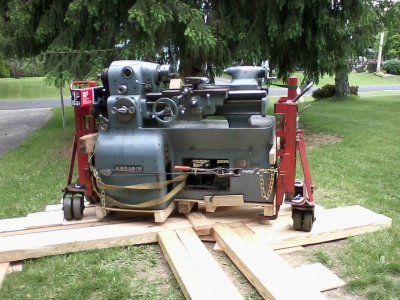-
Welcome back Guest! Did you know you can mentor other members here at H-M? If not, please check out our Relaunch of Hobby Machinist Mentoring Program!
You are using an out of date browser. It may not display this or other websites correctly.
You should upgrade or use an alternative browser.
You should upgrade or use an alternative browser.
Monarch being delivered
- Thread starter Walt
- Start date
- Joined
- Sep 24, 2010
- Messages
- 3,096
Those cribbing timbers look like they are pretty heavy duty too. Once you get the lathe moved to the basement you can use the timbers to build a tooling shadow board and bench. There would be no issues with the bench being strong enough, that is for sure. Where did you find it? It looks like it has been used pretty sparingly form it's cleanliness, but you never can tell till you run it and see what it will do. Is it a multi phase motor or single. If it is a multi are you planning to use a VFD or a RPC? Lots of different options available for that too. Good luck on the move and keep them pics coming!!!
Bob
Bob
Those cribbing timbers look like they are pretty heavy duty too. Once you get the lathe moved to the basement you can use the timbers to build a tooling shadow board and bench. There would be no issues with the bench being strong enough, that is for sure. Where did you find it? It looks like it has been used pretty sparingly form it's cleanliness, but you never can tell till you run it and see what it will do. Is it a multi phase motor or single. If it is a multi are you planning to use a VFD or a RPC? Lots of different options available for that too. Good luck on the move and keep them pics coming!!!
Bob
Hi Bob,
I bought the 4x6" timbers new from a local lumber yard for moving this lathe. (They will get used again. I already had a Precision Mathews mill on order when this lathe came up for sale!) My brother hauled the lathe on his trailer, but could not see a way to get access to my walk-in basement.

The Roll-A-Lifts are the blessing/curse making the move possible. They have the "toe-jack" configuration that makes it possible to get under a heavy machine, and the strength to lift it. The caster-mounted wheels make it possible to move any direction, but they also head downhill and off course at the worst possible time. The C-clamps across the caster turntable (picture) make it more likely the lathe will move where I've pointed it. In the picture I have the jack toes supported by a block of wood and have started pulling the wheels up level with the timber rails.

The main reason I decided to go with timbers instead of just rolling over plywood is my yard is sloped away from the house and I need to move the lathe sideways across that slope. I was more sure of how to shim timber into level than a sheet of plywood. Letting the lathe get any amount of lean backward or forward (toward the operator station) is not a good thing. Absolutely terrifying is probably a more accurate description. Side to side it's very stable. It took me 6 hours of work to move the lathe 50'. 12 hours if you count the time running to the lumber yard, cutting timbers, getting the lathe up onto the rail timbers, etc. You may notice the cable attached to the back of the lathe. It takes all my strength to lever it forward. Even at a fraction of one mile per hour, the momentum it has is incredible. It's very important to not get "rolling along". Moving an inch or two at a time is vital to safety, mine and the Monarch's.
The story of the lathe is it's a find from Craigslist. The previous owner was about 20 miles from my house. He says he bought if from a machinery dealer who sold his inventory to get out of the business. This lathe was going to be his special project for himself, but he never got around to refurbishing it. The guy I bought from intended to change the drive to something more simple and modern. I found the thread he started over on PM. The folks over there convinced him it was a bigger project than he really wanted to take on either to change or restore the original drive.
I have very little experience with lathes and have no ability to evaluate its condition beyond noting there are no obvious signs of wear on the ways like grooves or dings.

It's a 1941 model with a motor-generator set. I hope to get the original drive going again using a rotary phase converter. There is a beat-up DC power supply of dubious origin (no manufacturer label) that comes with the lathe, I'll evaluate that for parts. It's going to take a while to get the lathe running. I've been reading everything I can find.
Walt



- Joined
- Jun 22, 2012
- Messages
- 1,552
Wow, that is some cool looking lathe. I wonder what the weight is. Keep us updated on the progress.
- Joined
- Sep 3, 2011
- Messages
- 478
Walt,
Glad to see that you have the machine! I was following the thread about it over at PM. I'll be more than happy to help you get the drive running again. I have a 1943 motor/generator 10EE.
I love the roll-a-lifts. Are you renting them?
Cal
Glad to see that you have the machine! I was following the thread about it over at PM. I'll be more than happy to help you get the drive running again. I have a 1943 motor/generator 10EE.
I love the roll-a-lifts. Are you renting them?
Cal
they weigh about 3200 with everything intact. nice move Walt! Would pipe rollers have worked or were the roll-a-hoists a necessity?
I never count the trips to get the tools we need in the time it takes to do something:whistle:
Hi Toag,
I think rollers might have been a better choice (at this point), but my brother who trucked the lathe for me used the Roll-A-Lifts to get the Monarch up onto his trailer. He left them with me for the move to the basement.
I would have had to build a skid to go under the lathe with timbers running the length of it for the rollers, then remove the pallet currently under the lathe and get the new skid under it. Not an insurmountable problem, but the lathe has to be turned 90 degrees 3 times during the move, and I wasn't clear on how to do that with pipes on timbers. All the postings I found on the subject had concrete to roll on. I did purchase a length of 2" diameter pipe for a backup in case the current plan fails.
I made a turntable out of 2" pipe flanges and use the wheels to steady the lathe during the pivot. It takes forever to get everything in place and level!
Walt
- - - Updated - - -
Remember to keep your jack release close at hand in case you get a runaway you can just lower the back end to the ground.:tiphat:
Yes!!!
Walt
- Joined
- Sep 3, 2011
- Messages
- 478
Walt,
I'm just curious, did you have room to get a truck and trailer or a flat-bed wrecker around to the basement door? $50 to have a wrecker pick the lathe up and drop it around back would be a fairly typical charge. A Bil-Jax type trailer with a lowering deck makes moving machines sooooo much easier.
http://www.biljax.com/products/et-7000/
Cal
I'm just curious, did you have room to get a truck and trailer or a flat-bed wrecker around to the basement door? $50 to have a wrecker pick the lathe up and drop it around back would be a fairly typical charge. A Bil-Jax type trailer with a lowering deck makes moving machines sooooo much easier.
http://www.biljax.com/products/et-7000/
Cal
Walt,
Glad to see that you have the machine! I was following the thread about it over at PM. I'll be more than happy to help you get the drive running again. I have a 1943 motor/generator 10EE.
I love the roll-a-lifts. Are you renting them?
Cal
Hi Cal,
Thanks much for your kind offer of help. I've been reading as many posts on the Monarch as I can and your name keeps coming up, it's wonderful that you do so much to share your knowledge.
I'm in way over my head on the motor-generator. It seems like the next logical step after getting the lathe in place is to start building a rotary phase converter, but I may be missing a step or more. Any comments on what needs to be checked before connecting electricity? I saw a table of resistance checks in a post at PM for trouble shooting the M-G set, maybe I should start there?
The Roll-A-Lifts are on loan courtesy of my brother. I spent hours looking on-line for a place to rent them and came up empty. I'm hoping to get them back to him very soon and not make him regret his generosity. If I need to move the lathe after it's in my shop, a pallet jack or pipes will do the job (I hope!)
Walt

